Fez is known as Morocco’s ancestral jewel, offering visitors a unique journey through time to explore the historical monuments, religious sites, and markets that have shaped its identity over the centuries. With its ancient buildings and intertwining alleyways, Fez is considered one of the most authentic Islamic cities in the world, where the splendor of traditional architecture blends with vibrant daily life.
In this comprehensive guide, we will cover the most important historical and religious monuments of Fez such as Al-Qarawiyyin Mosque, Al-Attarine Madrasa, and the Zawiya of Moulay Idriss II, as well as remarkable sites like Bab Boujloud and Fez el-Jdid, not forgetting the famous souks of Fez that abound with handicrafts and traditional products. We will also take a look at Moulay Yacoub, located near Fez and famous for its thermal baths.
Prominent Religious and Historical Monuments of Fez
Fez is rich in religious and historical monuments of global importance, reflecting its status as the spiritual and cultural capital of Morocco, attracting visitors from around the world eager to explore its rich and diverse heritage.
Al-Qarawiyyin Mosque and University
Al-Qarawiyyin Mosque is one of the oldest and most important religious and educational monuments, not only in Fez but throughout the Islamic world. Founded in 859 AD by Fatima al-Fihriya, it houses the world’s oldest continuously operating university. The mosque is distinguished by its unique Islamic architecture, vast courtyard adorned with Moroccan zellige tilework, and delicate wood carvings.
It is important to note that entrance to the mosque is reserved for Muslims, but non-Muslim visitors can admire the magnificence of its structure from the outside and through certain open entrances that allow glimpses of part of the inner courtyard.
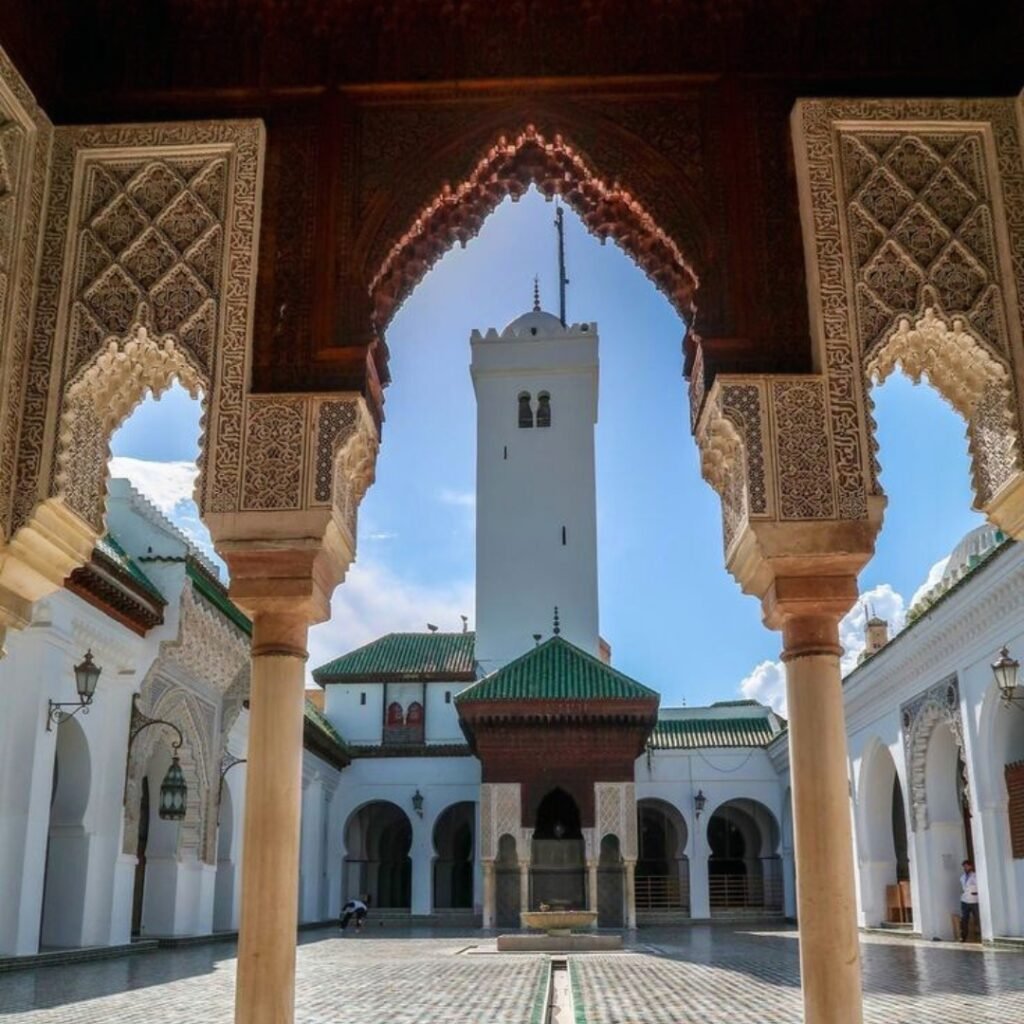
Al-Attarine Madrasa
Al-Attarine Madrasa is one of the most beautiful religious schools in Morocco, an architectural masterpiece from the Marinid era built in 1325. Used as a school for teaching the Quran and religious sciences, it is distinguished by its stunning architectural decorations that combine the art of zellige, sculpted plaster, and finely carved wood.
Unlike mosques, visiting Al-Attarine Madrasa is accessible to all tourists for a nominal entrance fee, offering a magnificent opportunity to discover traditional Moroccan Islamic architecture and the splendor of its meticulous design.
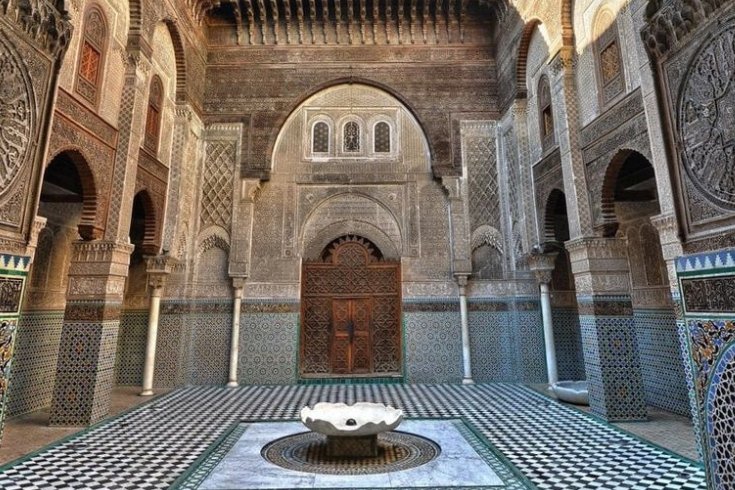
Zawiya of Moulay Idriss II
The Zawiya of Moulay Idriss II is one of the most sacred religious sites in Fez, housing the mausoleum of the city’s founder, Prince Idriss II. Located in the heart of the old city, it is characterized by its green dome and authentic Islamic architecture, and serves as a destination for Muslim visitors from around the world who come to pray and seek blessings.
As with mosques, entry to the zawiya is reserved for Muslims, but non-Muslim visitors can observe the ornate door and exterior facade decorated with zellige and traditional engravings.
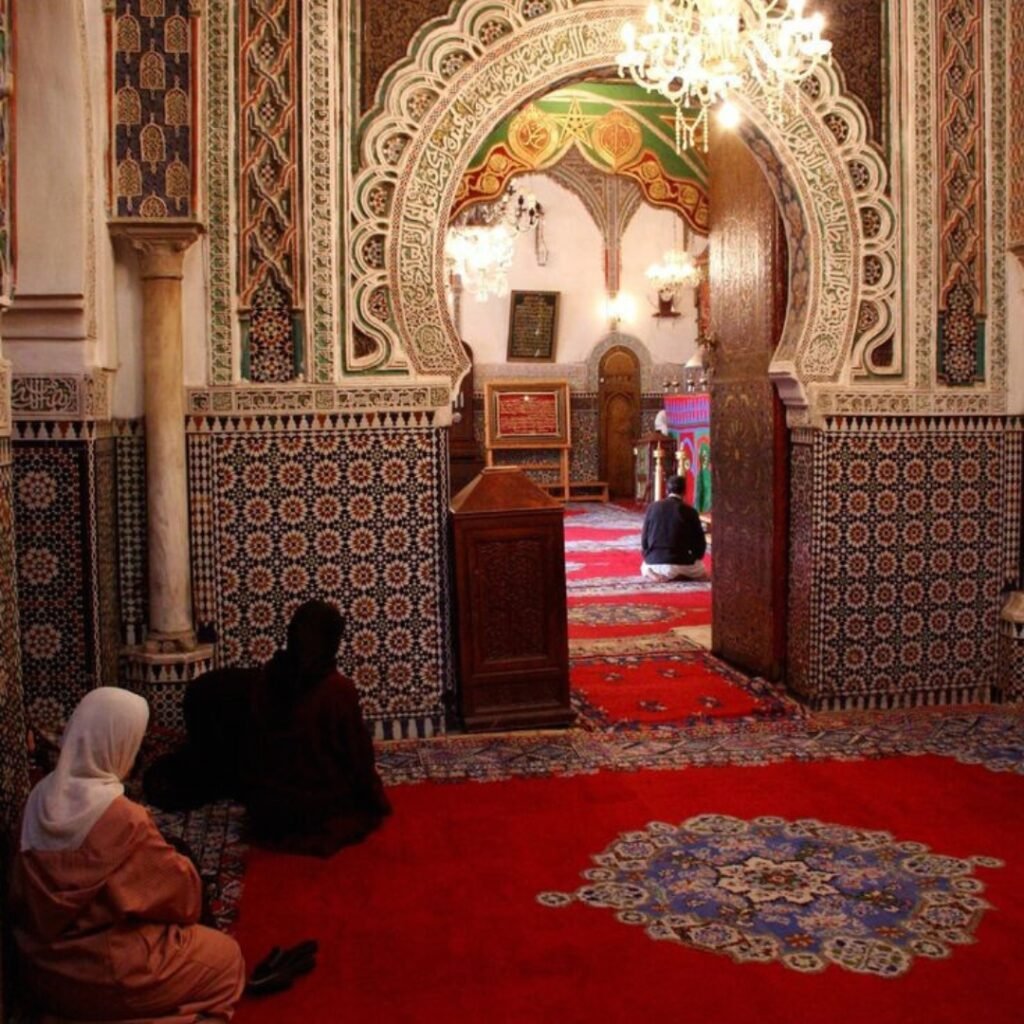
Historical Gates and Districts of Fez
Beyond the main religious sites, Fez also offers magnificent gates and distinctive historical districts worth exploring, each with its own character and rich history.
Bab Boujloud – The Blue Gate
Bab Boujloud, also known as the “Blue Gate,” is the main and most famous entrance to Fez el-Bali (the old city). Built in 1913 during the French protectorate period, it is distinguished by its unique design: its exterior facade is blue (symbolizing Fez), while its interior facade is green (symbolizing Islam).
Bab Boujloud serves as an important meeting point and easily recognizable monument, as well as an ideal starting point for exploring the labyrinth of alleys in the old city and the various souks that extend behind it.
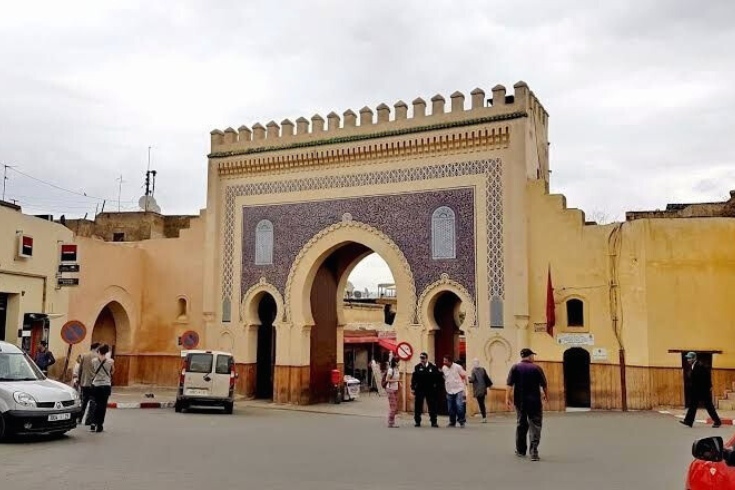
Fez el-Jdid (The New City)
Despite its name meaning “New,” Fez el-Jdid dates back to the 13th century and constitutes a distinct historical district that differs in its planning and character from Fez el-Bali (the old city). Fez el-Jdid includes:
- The Royal Palace: Although not accessible to the public, its immense gates adorned with copper and decorations are worth admiring.
- The Mellah: The historic Jewish quarter characterized by its unique architecture with wooden balconies overlooking the streets, reflecting the history of religious coexistence in Morocco.
- Gardens and squares: Which offer more spacious areas compared to the narrow alleys of Fez el-Bali.
Visiting Fez el-Jdid is an opportunity to discover another facet of the city’s history and its diverse social fabric through the ages.

The Souks of Fez: A Labyrinth of Crafts and Traditional Commerce
A visit to Fez would not be complete without immersion in the world of traditional markets (souks), which are an integral part of the city’s identity and Moroccan traditional products reflecting the richness of craftsmanship passed down through generations.
The Atmosphere of the Souks and the Maze of Alleyways
The souks of Fez form a true labyrinth of narrow, intertwining alleyways that extend north of Al-Qarawiyyin Mosque and Al-Attarine Madrasa. As soon as visitors enter these souks, they are immersed in a unique sensory experience: the sounds of artisans working diligently, the smells of spices, leather, and perfumes filling the air, and the colorful sights of products displayed in small adjacent shops.
One can spend long hours exploring these souks without getting bored, as each corner hides a new surprise and each alley opens onto a different world of crafts and products.
The Main Types of Souks and Products
The souks of Fez are specialized according to the type of craft or product, and are generally named after the predominant trade. Among the most important:
- Tanners’ Souk: Famous for its leather tanneries, notably the famous Chouara Tannery, where one can observe the traditional process of leather tanning in colorful vats, then purchase leather products in neighboring souks.
- Dyers’ Souk: Where fabrics and threads are dyed in bright colors using natural materials, offering an artistic tableau of colors hung to dry.
- Coppersmiths’ Souk: Specialized in manufacturing copper and metal objects, where one can observe artisans engraving and hammering copper with inherited skill.
- Spice Merchants’ Souk: Renowned for selling spices, medicinal herbs, and traditional perfumes, with distinctive colors and scents.
- Carpenters’ Souk: Specialized in carved woodwork and traditional furniture.
- Carpet Souk: Where authentic Moroccan carpets and rugs with varied designs are sold.
It is important to note that bargaining is expected and necessary in these souks, and navigating them can be difficult at first due to the maze of alleyways, but this is part of the charm and unique experience that the souks of Fez offer.
The Importance of These Monuments and Souks of Fez
The historical and religious monuments as well as the souks of Fez represent an exceptional cultural and civilizational heritage, reflecting the importance of the city as a beacon of science, culture, and commerce through the centuries. The old city of Fez was inscribed on UNESCO’s World Heritage List in 1981, in recognition of its exceptional value and historical importance.
These sites combine religious, historical, artistic, and commercial significance, and offer a unique opportunity for visitors to understand authentic Moroccan and Islamic identity and discover traditional ways of life that persist to this day in the heart of the old city.
Visiting the Monuments and Souks of Fez: Practical Guide
To explore these historical and religious monuments and souks of Fez, here are some practical tips that will help you enjoy a unique and comfortable experience.
Getting Around Fez el-Bali – The Old City
Walking is the main means of transportation in Fez el-Bali, as it is difficult for cars to access most of its narrow alleys. You will notice the use of donkeys and mules to transport goods through the alleys, a traditional scene that persists in the daily life of the city.
It is recommended to wear comfortable and suitable shoes for walking long hours on sometimes uneven ground. It is also strongly advised to hire a local tour guide, especially during a first visit, who will help you:
- Avoid getting lost in the maze of alleys
- Easily access the main monuments
- Obtain valuable historical and cultural information
- Avoid potential harassment from certain unofficial “guides”
Rules for Visiting and Behavior – Especially for Religious Sites and Souks
When visiting religious sites, please respect:
- Wear modest clothing covering shoulders and knees
- Respect access restrictions to mosques and zawiyas, reserved for Muslims
- Maintain calm and respect around religious sites
- Ask permission before taking photos at certain sites
As for the souks, it is advisable to:
- Bargain politely on prices, it’s part of the local culture
- Pay attention to your personal belongings in crowded places
- Ask permission before photographing artisans or their products
- Not display large sums of money while shopping
To access Fez el-Jdid from Fez el-Bali, you can use small taxis (Petit Taxi), then walk between its various monuments like the Royal Palace and the Mellah.
The best time to visit is in spring and autumn, when the weather is moderate and conducive to walking. As for the time of day, early morning and evening are considered the best times to visit the souks when they are lively.
It should be noted that visiting certain sites like Bab Boujloud and walking through the souks are free, while visiting major sites like religious madrasas requires variable entrance fees.
Moulay Yacoub: A Relaxing Destination Near Fez
Moulay Yacoub is not part of the city of Fez itself, but it is a popular nearby destination that can be visited for a relaxing and pleasant trip away from the hustle and bustle of the city.
About Moulay Yacoub
Moulay Yacoub is famous for its thermal baths and therapeutic waters rich in minerals, which visitors from all over Morocco and the world frequent for healing and relaxation. The region includes traditional bath facilities and modern ones equipped with the latest therapeutic technologies.
The waters of Moulay Yacoub are characterized by their naturally high temperature (around 54 degrees Celsius) and their richness in sulfur and beneficial minerals for treating many skin and joint diseases and stimulating blood circulation.
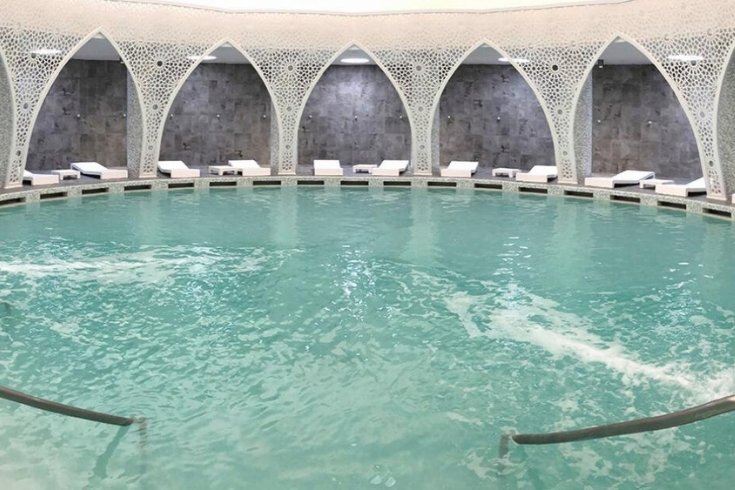
How to Get to Moulay Yacoub from Fez
Moulay Yacoub is located about 22 kilometers northwest of the city of Fez, and can be easily accessed in 30-45 minutes by car.
Several options are available to get there:
- Grand Taxis: They depart regularly from Fez to Moulay Yacoub and constitute the most common and economical option.
- Car rental: For those who prefer freedom and flexibility of movement.
- Organized tours: Some tourist agencies in Fez offer day trips to Moulay Yacoub including treatments and relaxation.
It is recommended to dedicate an entire day to visiting Moulay Yacoub to enjoy the experience of thermal baths and wellness center services without rushing.
Conclusion: Fez… City of History, Religion, and Commerce Awaits You
The historical and religious monuments and souks of Fez represent a unique civilizational treasure that deserves to be explored and contemplated. From the splendor of the ancient Al-Qarawiyyin Mosque and the beauty of Al-Attarine Madrasa, to the magic of Bab Boujloud and the authenticity of Fez el-Jdid, to the labyrinth of vibrant souks with traditional crafts, Fez offers an incomparable tourist experience that blends past and present in perfect harmony.
Don’t miss the opportunity to relax in the thermal baths of nearby Moulay Yacoub, to complete your cultural and tourist experience in this region rich in heritage and history.
We invite you to visit Fez and explore its historical and religious monuments and ancient souks, using this guide to organize your trip. Don’t hesitate to share your experiences and photos of this enchanting city, and don’t forget to plan a visit to Moulay Yacoub to enjoy unforgettable moments of relaxation.


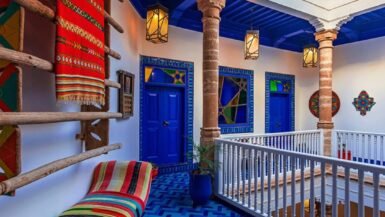


Leave a reply